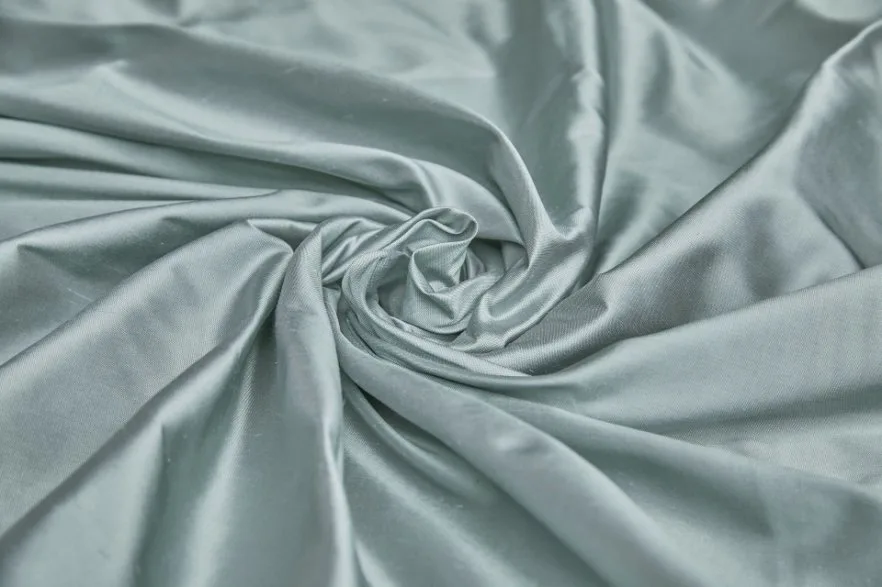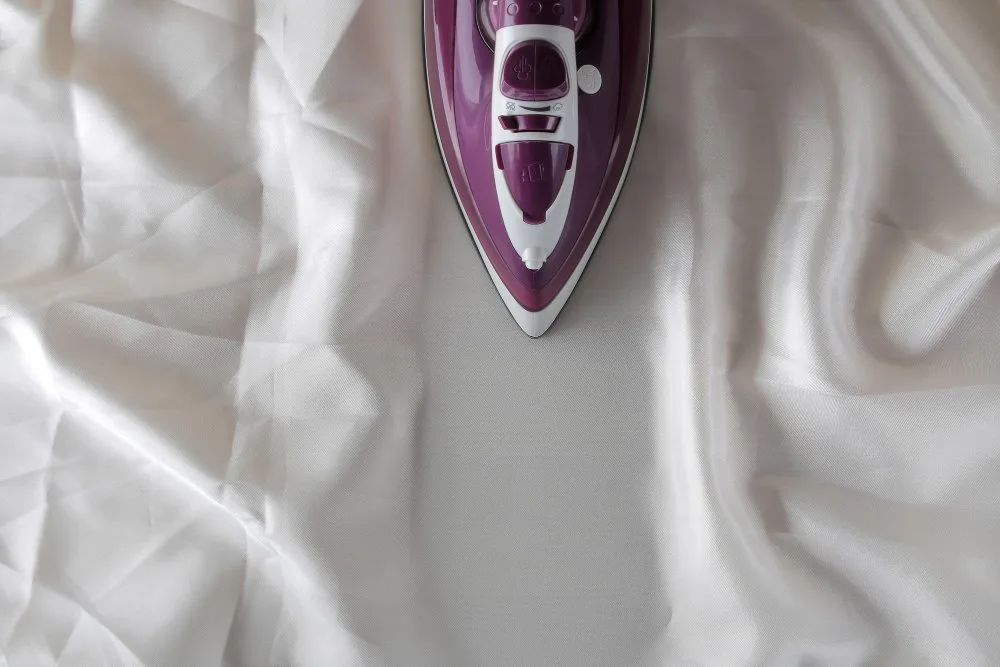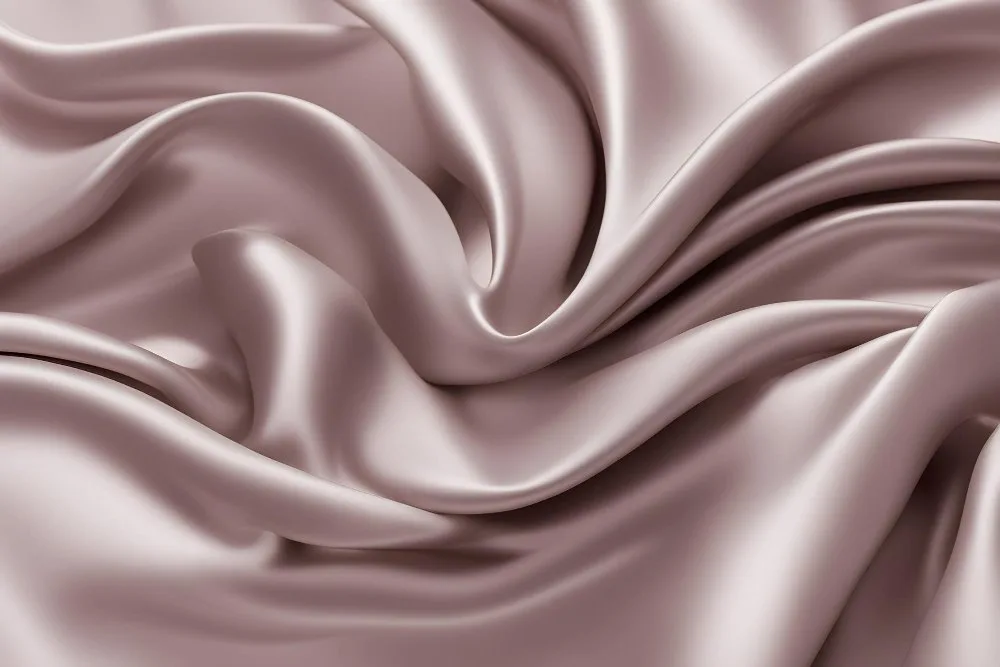Everything you need to know about Dupioni silk’s unique characteristics, history, care, and uses in fashion and home decor
Table of Contents
- What is Dupioni Silk?
- The Rich History of Dupioni Silk
- How Dupioni Silk is Made
- Unique Characteristics and Properties
- Dupioni vs. Other Silk Types
- The Mulberry Silk Connection
- Uses and Applications
- Complete Care Guide
- Sewing with Dupioni Silk
- How to Choose Quality Dupioni
- Buying Guide and Price Ranges
- Sustainability and Ethics
- Dupioni Silk Trends in 2025
- Frequently Asked Questions
- Conclusion
If you’ve ever run your hand across a piece of fabric that feels slightly bumpy yet incredibly luxurious, with a natural shimmer that seems to change colors in different light, you’ve probably touched Dupioni silk. This unique fabric has been captivating fashion designers, home decorators, and textile lovers for centuries with its perfectly imperfect texture and stunning visual appeal.
Unlike the smooth, slippery silks you might be familiar with, Dupioni has personality. It has character. And once you understand what makes this fabric special, you’ll know exactly when and why to choose it for your next project.
What is Dupioni Silk?
Dupioni silk (also spelled dupion, douppioni, or doupioni) is a type of plain weave silk fabric known for its distinctive slubbed texture and natural sheen. The name comes from the Italian word “doppione,” meaning double, which refers to how this silk is created.
Is dupioni silk real silk? Yes, absolutely! Dupioni is 100% real silk made from the cocoons of silkworms, specifically the Bombyx mori species that feeds on mulberry leaves.
The Defining Features
What makes Dupioni different from other silks is its texture. When you look closely at Dupioni fabric, you’ll notice small bumps and irregularities running horizontally across the fabric. These are called “slubs,” and they’re not defects. They’re actually what makes Dupioni silk so beautiful and sought-after.
The fabric has a crisp, slightly stiff hand (that’s textile-speak for how it feels when you touch it). It’s not drapey or flowing like chiffon or charmeuse. Instead, it holds its shape well, which makes it perfect for structured garments and home decor items that need body.
What is a Dupion Fabric?
A dupion fabric refers specifically to this textured silk created using fine yarn in the warp (the lengthwise threads) and irregular yarn in the weft (the crosswise threads). This combination creates a tightly woven material with high luster and a crisp finish. The weft threads come from double cocoons, which we’ll explain more about in the production section.
The Rich History of Dupioni Silk
The story of silk begins in ancient China around 2700 BCE, where silk production was discovered and fiercely guarded as a state secret. For thousands of years, China held a monopoly on silk production, and the punishment for revealing the secrets of sericulture (silk farming) was death.
According to historical textile records, silk traveled along the famous Silk Road, reaching the Middle East and eventually Europe.
From China to Europe
Silk traveled along the famous Silk Road, reaching the Middle East and eventually Europe. By the Byzantine Era (around 550 AD), silk production had spread to Constantinople when, according to legend, monks smuggled silkworm eggs out of China in hollow canes.
The term “dupioni” itself emerged during the Italian Renaissance, when Italian weavers began specifically cultivating and using double cocoons to create this textured silk. Italy, particularly the regions around Como and Milan, became famous for producing high-quality Dupioni silk.
Where is Dupioni Silk Made Today?
Today, Dupioni silk is produced in several countries:
- India: Varanasi (also known as Banaras) is now the world’s leading producer of Dupioni silk. Local weavers, mainly from the Ansari community, have been producing this fabric for generations. The city’s Banarasi Dupion silk sarees are particularly famous worldwide.
- China: Still a major producer, especially of machine-woven Dupioni
- Thailand: Known for producing vibrant, hand-woven Dupioni
- Japan: Produces high-quality Dupioni, where double cocoons are called “tamamayu”
- Italy: Continues to produce luxury Dupioni for haute couture
During medieval Europe, Dupioni became popular among royalty for its durable nature and bright finish. It quickly became the fabric of choice for royal attire, and that association with luxury continues today.
How Dupioni Silk is Made
Understanding how Dupioni silk is produced helps explain why it looks and feels the way it does. The process is pretty amazing when you think about it.
The Double Cocoon Phenomenon
Here’s where things get interesting. Normally, one silkworm spins one cocoon. But sometimes, two silkworms spin their cocoons together, either because they’re placed too close together or because they naturally decide to share space. When this happens, you get what’s called a double cocoon.
These double cocoons can’t be unwound smoothly like single cocoons. Instead, the silk fibers from both worms get tangled together, creating an irregular, thicker thread in some places and thinner in others. These variations are what create those characteristic slubs in the finished fabric. This process is well-documented in sericulture research.
In modern production, manufacturers actually encourage this by deliberately placing silkworms close together during the cocooning stage. It’s a controlled process designed to create that signature Dupioni texture.
The Weaving Process
Making Dupioni silk involves specific weaving techniques:
- Harvesting: Cocoons are collected and sorted. Double cocoons are separated for Dupioni production.
- Reeling: The irregular silk threads are carefully reeled from the double cocoons. This silk becomes the weft (horizontal) threads.
- Preparing the Warp: Fine, smooth silk threads are prepared for the warp (vertical threads). These need to be strong because they’re under constant tension during weaving.
- Weaving: The fabric is woven using a plain weave technique. High-quality Dupioni is hand-woven, while more affordable versions are machine-woven.
- Finishing: The fabric may be washed and treated to enhance its natural luster.
Why Different Threads for Warp and Weft?
The slubbed Dupioni threads are too weak and irregular to use as warp threads. The warp bears all the tension during weaving, so it needs smooth, strong threads. That’s why only the weft (crosswise threads) use the irregular double-cocoon silk. This is also why the slubs always run horizontally across Dupioni fabric, never vertically.
Hand-Woven vs. Machine-Woven
Traditional Dupioni silk is hand-woven, which creates a more irregular, artisanal look. Hand-woven Dupioni tends to be more expensive but also more interesting, with greater variation in the slub size and placement.
Machine-woven Dupioni is more uniform and affordable. It still has the characteristic slubs, but they’re more consistent. Neither is better or worse; it depends on what look you’re going for and your budget.
Unique Characteristics and Properties
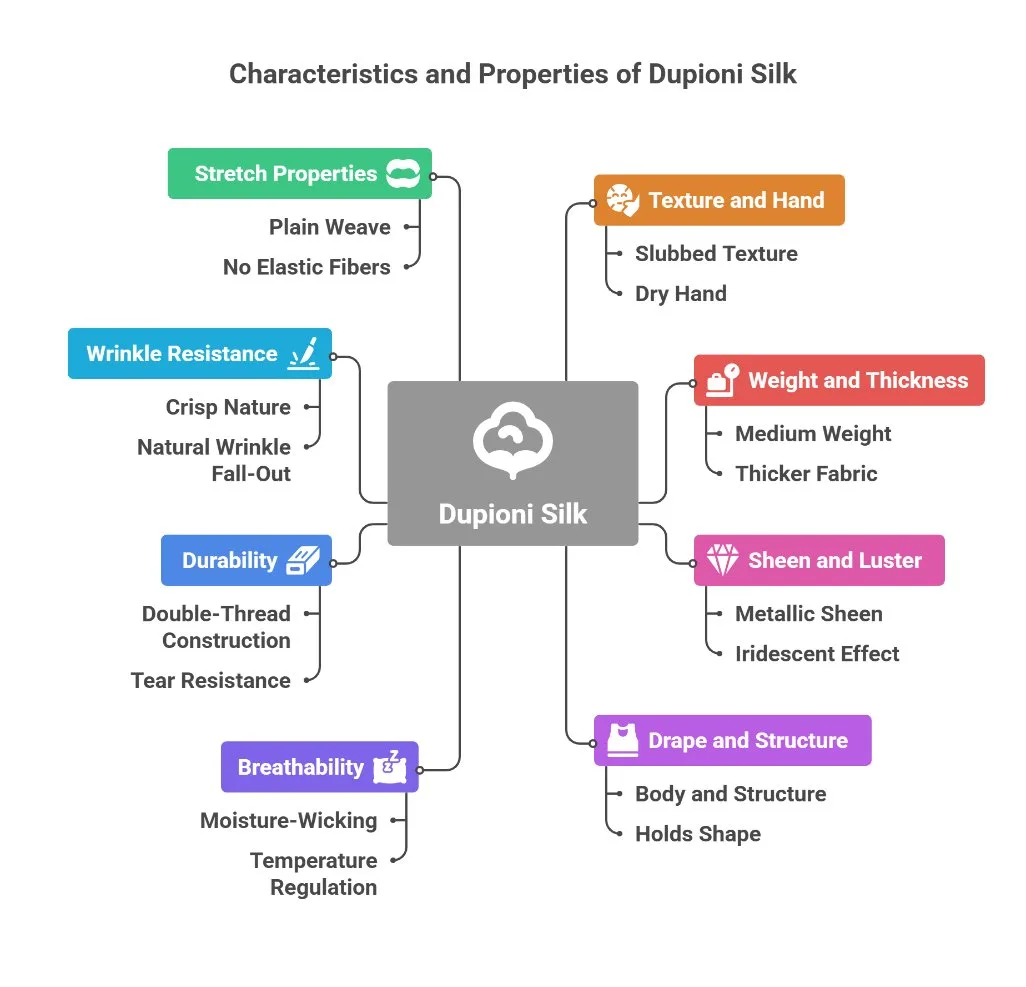
Let’s talk about what makes Dupioni silk behave the way it does. Understanding these properties will help you decide if it’s right for your project.
Texture and Hand
The most obvious characteristic of Dupioni is its slubbed texture. When you run your hand across it, you can feel those little bumps. The fabric has what textile professionals call a “dry hand” or “crisp hand.” It doesn’t feel slippery or smooth like other silks.
How stiff is silk Dupion? Dupioni is moderately stiff, especially when new. It has body and structure, similar to taffeta but not quite as rigid. This stiffness can be softened through washing or steaming (more on that in the care section).
Weight and Thickness
Is Dupion silk heavy? Dupioni is considered a medium to medium-heavy weight silk. It’s heavier than charmeuse or habotai silk but lighter than some brocades. The weight is typically measured in momme (a unit for measuring silk density), and Dupioni usually ranges from 12 to 19 momme.
The fabric is slightly thicker than most other silks due to the double threads in the weft. This makes it more durable and easier to work with for beginners.
Sheen and Luster
Dupioni has a natural, almost metallic sheen. But here’s what’s cool: the luster isn’t uniform. Because of those irregular slubs, light catches the fabric differently across its surface. This creates what’s called an “iridescent effect,” where the fabric seems to shimmer and change color slightly as you move it or as light hits it from different angles.
This effect is often enhanced by using different colored threads in the warp and weft. For example, a blue warp with a gold weft creates a fabric that looks blue from one angle and gold from another.
Drape and Structure
Unlike flowing silks, Dupioni has body and structure. It doesn’t cling to the body or drape softly. Instead, it stands away from the body, holding its shape. This makes it perfect for full skirts, structured jackets, and home decor items like curtains that need to hold pleats.
Breathability
Is Dupioni silk breathable? Yes! Like all natural silks, Dupioni is breathable and temperature-regulating. Silk naturally wicks moisture away from the skin and helps keep you cool in summer and warm in winter. The slightly looser weave of Dupioni (compared to tightly woven satins) actually makes it quite comfortable to wear.
Durability
Is dupioni silk good quality? In terms of durability, Dupioni is actually one of the stronger silks. The double-thread construction in the weft makes it more resistant to tearing than many smoother silks. However, like all silks, it can still be damaged by rough handling, water spots, or sunlight exposure.
Wrinkle Resistance
Does dupioni silk wrinkle? Here’s good news: Dupioni is relatively wrinkle-resistant compared to other silks! The crisp, slightly stiff nature of the fabric helps it resist creasing. Small wrinkles often fall out naturally. However, if you do get deep creases, they’ll need steaming or careful ironing to remove.
Stretch Properties
Does Dupioni silk stretch? No, Dupioni has very little stretch. It’s woven in a plain weave with no elastic fibers, so there’s minimal give. This lack of stretch is actually a benefit for home decor and structured garments where you want the fabric to maintain its shape.
Does Silk Dupion Have a Right and Wrong Side?
Technically yes, but they’re similar. The right side (face) is slightly smoother and shinier, while the wrong side (back) has a slightly rougher texture with more visible flaws. However, Dupioni is essentially reversible, and many sewers deliberately use the “wrong” side for a more matte, textured look.
Dupioni vs. Other Silk Types
Not all silks are created equal. Let’s compare Dupioni to other popular silk types so you know exactly what you’re getting.
| Silk Type | Texture | Weight | Drape | Sheen | Best For | Price Range |
|---|---|---|---|---|---|---|
| Dupioni | Slubbed, textured | Medium-heavy | Structured, stiff | Natural, iridescent | Formal wear, home decor | $$ |
| Charmeuse | Smooth, slippery | Light-medium | Fluid, drapey | High, satin-like | Lingerie, blouses, dresses | $$$ |
| Shantung | Slightly slubbed | Light-medium | Crisp, some body | Moderate | Suits, dresses | $$ |
| Taffeta | Smooth, crisp | Medium-heavy | Very stiff | High, glossy | Ball gowns, formal wear | $$$ |
| Habotai | Smooth, soft | Light | Very drapey | Moderate | Linings, scarves | $ |
| Raw Silk/Noil | Nubby, matte | Medium | Moderate | Low, matte | Casual wear | $ |
What is Dupioni Silk vs Silk?
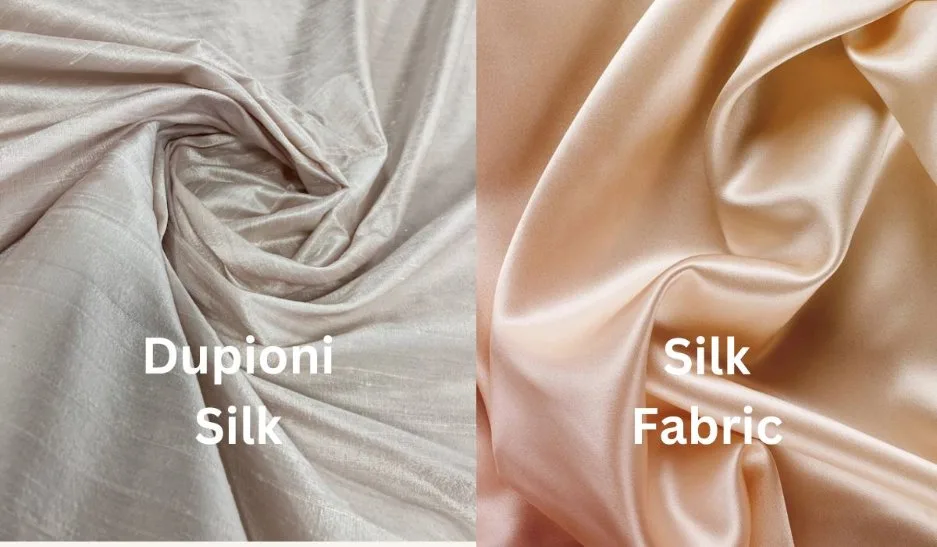
When people ask “dupioni silk vs silk,” they’re usually comparing Dupioni to smooth, classic silk like charmeuse or habotai. The main differences are texture (Dupioni is slubbed), weight (Dupioni is heavier), and drape (Dupioni is stiffer). All are real silk, just different types.
Is Dupioni the Same as Shantung?
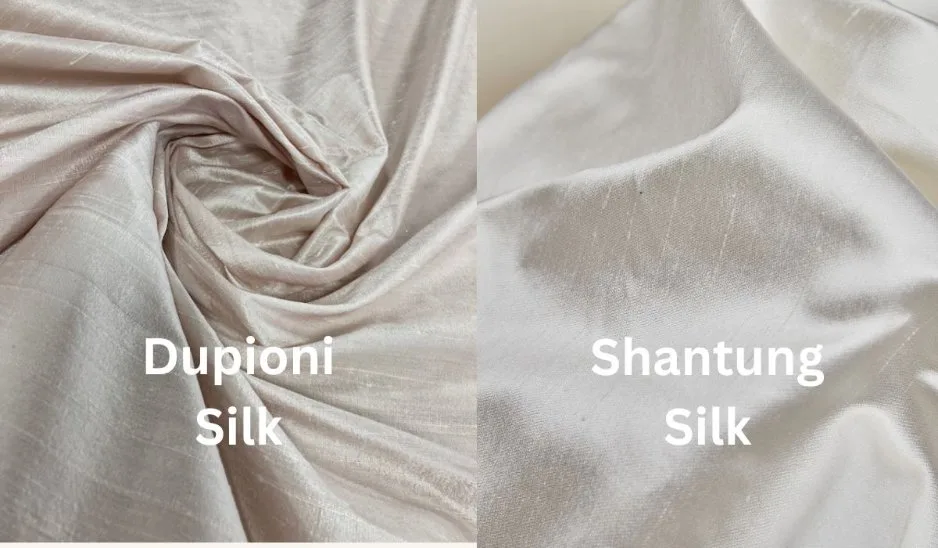
No, but they’re very similar and often confused. Both have slubs and a crisp feel. The main differences:
- Shantung has smaller, less prominent slubs and is usually machine-woven. It’s slightly lighter and smoother.
- Dupioni has larger, more irregular slubs and is often hand-woven. It’s slightly heavier and more textured.
Think of Shantung as Dupioni’s slightly more refined cousin. Both originated from different regions in China (Shantung from Shandong province, Dupioni from double cocoons).
What Does Dupion Mean in French?
While Dupioni has Italian origins (from “doppione”), in French textile terminology, “dupion” or “douppion” refers to the same fabric. The term isn’t specifically French but has been adopted into French fashion vocabulary as the fabric gained popularity across Europe.
What is the Difference Between Dupioni and Charmeuse?
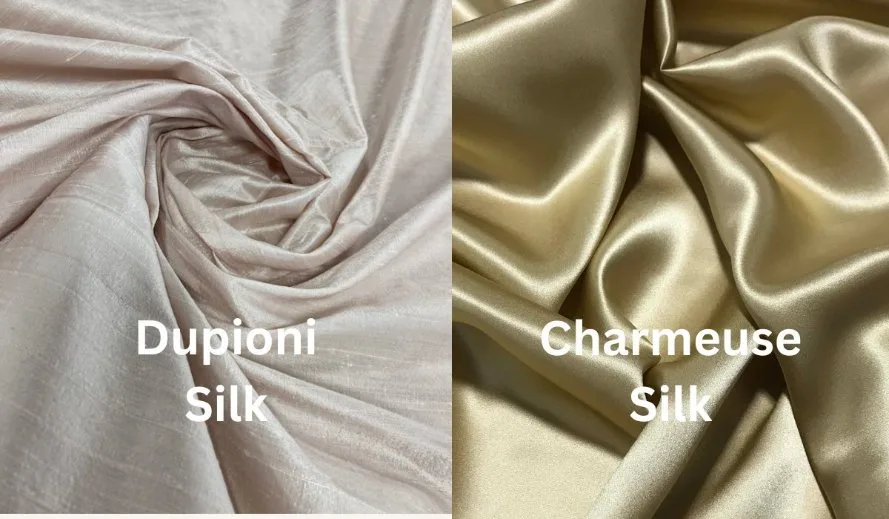
These are almost opposite types of silk:
Dupioni
- Textured, slubbed surface
- Crisp and structured
- Moderate sheen
- Holds shape well
- Best for formal wear and decor
Charmeuse
- Smooth, slippery surface
- Drapey and fluid
- High, satin-like sheen
- Clings to body
- Best for lingerie and flowing garments
What is the Difference Between Dupion Silk and Tussar Silk?
Tussar (or Tussah) silk and Dupioni are fundamentally different:
- Tussar silk comes from wild silkworms (not Bombyx mori) and has a natural golden-tan color, coarser texture, and matte finish. It’s considered a “wild silk.”
- Dupioni silk comes from cultivated mulberry silkworms and can be dyed any color. It has a shinier finish and is made specifically from double cocoons.
The Mulberry Silk Connection

This is important to understand: Dupioni IS made from mulberry silk. There’s sometimes confusion about this, so let’s clear it up.
What is the Difference Between Mulberry Silk and Dupion Silk?
“Mulberry silk” refers to silk produced by Bombyx mori silkworms that feed exclusively on mulberry leaves. This is the highest quality silk and accounts for about 90% of the world’s silk production.
Dupioni silk is a TYPE of mulberry silk. The difference isn’t in the source (both come from Bombyx mori worms) but in HOW it’s produced. Regular mulberry silk comes from single cocoons and is reeled into smooth threads. Dupioni mulberry silk comes from double cocoons and results in irregular, slubbed threads.
Think of it like this: All Dupioni is mulberry silk, but not all mulberry silk is Dupioni. It’s like saying all golden retrievers are dogs, but not all dogs are golden retrievers.
Is Dupion Silk Raw Silk?
This gets a bit technical. “Raw silk” can mean two things:
- Unprocessed silk: Silk that still contains sericin (the natural gum that holds the cocoon together)
- Silk with texture: Silk that has a nubby, irregular surface
In the first sense, most Dupioni is NOT raw silk because the sericin has been removed. However, people sometimes call it “raw silk” because of its textured appearance. To be more accurate, Dupioni is “textured silk” or “slubbed silk,” not technically raw silk.
Is Dupioni Silk Spun or Filament?
Dupioni is primarily a filament silk. The threads come from unwinding cocoons (reeling), not from spinning short fibers together. However, the double cocoon process means the filaments can’t be reeled as smoothly as regular silk, creating some spun-like characteristics in the irregular areas.
Uses and Applications
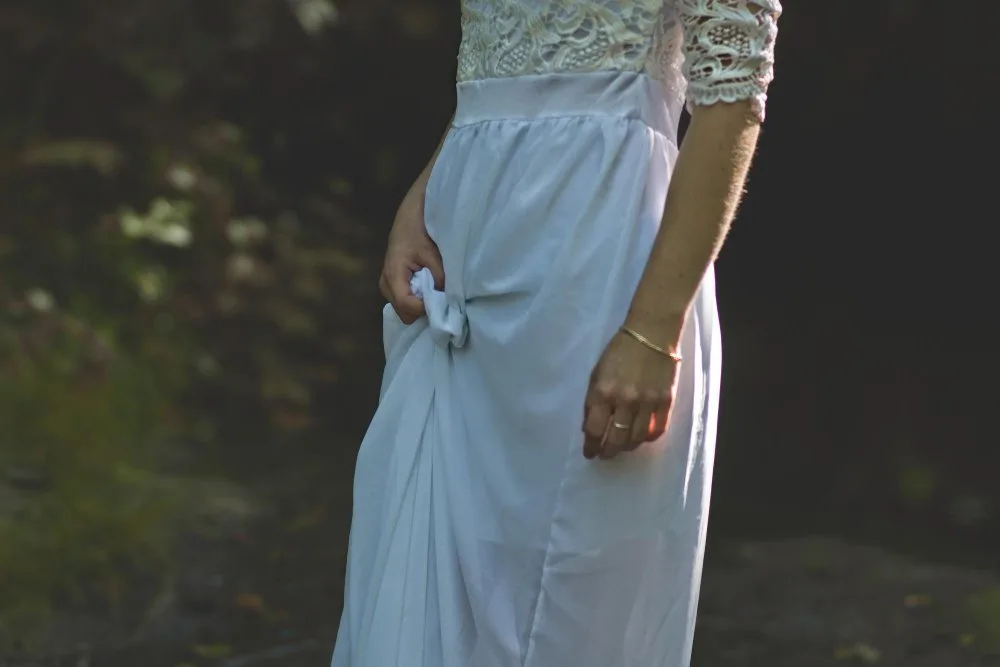
Dupioni’s unique properties make it perfect for specific applications. Here’s where this fabric really shines.
Bridal and Formal Wear
This is probably what Dupioni is most famous for. Is Dupion a type of silk used for wedding dresses? Absolutely! In fact, it’s one of the top choices for bridal gowns.
Why wedding dresses love Dupioni:
- The structure holds the shape of full skirts and ball gowns
- The slight texture adds visual interest without being too busy
- The natural sheen photographs beautifully
- It’s durable enough to last through a long wedding day
- The crisp hand creates beautiful pleats and gathers
Beyond wedding dresses, Dupioni is popular for:
- Bridesmaid dresses
- Mother-of-the-bride/groom outfits
- Christening gowns
- Prom dresses
- Evening gowns
- Formal suits and jackets
Home Decor
Dupioni is equally popular in interior design. Its durability and body make it perfect for:
- Curtains and Drapes: The fabric holds pleats beautifully and provides good light filtration. However, if using for window treatments, you’ll need a UV-protective lining because direct sunlight can damage silk.
- Upholstery: The durable nature makes it suitable for accent chairs and cushions (though not high-traffic furniture)
- Throw Pillows: Adds instant elegance to any room
- Table Linens: Tablecloths, runners, and napkins for special occasions
- Bedding: Duvet covers and decorative shams (though not usually for sheets due to the texture)
What is Banarasi Dupion Silk?
Banarasi Dupion silk refers specifically to Dupioni silk produced in Varanasi (Banaras), India. This silk is particularly prized for making traditional Indian sarees. Banarasi Dupion sarees are known for their bright colors, rich texture, and often feature intricate brocade work with gold or silver threads.
These sarees are considered luxury items in India and are popular choices for weddings and festivals. The weaving tradition in Varanasi goes back generations, with skills passed down through families.
Fashion Garments
Beyond formal wear, Dupioni can be used for:
- Structured jackets and blazers
- A-line or full skirts
- Tailored pants
- Vests and waistcoats
- Handbags and accessories
Other Creative Uses
- Historical costumes and Renaissance faire outfits
- Theatrical costumes
- Quilting (for special occasion quilts)
- Wall hangings and art pieces
- Gift wrapping for luxury items
Complete Care Guide: How to Care for Dupioni Silk Fabric
Proper care will keep your Dupioni silk looking beautiful for years. Here’s everything you need to know.
Can Dupioni Silk Get Wet?
Yes, but with caution. Dupioni silk can handle water, but it’s sensitive to water spots. If water droplets dry on the fabric, they can leave permanent marks. This is because water can disturb the natural oils in silk and cause the fibers to bunch up in spots.
Can Dupion Silk Be Washed?
Yes, but dry cleaning is safer. Let’s look at both options.
Dry Cleaning (Recommended)
Dry cleaning is the safest way to clean Dupioni silk, especially for:
- Formal garments you want to keep crisp
- Items with interfacing or special construction
- Pieces you’re worried about damaging
- Items with complex dye jobs or embellishments
Take your Dupioni to a cleaner experienced with silk. Point out any stains and specify that it’s Dupioni silk.
Hand Washing (For Those Who Dare)
Hand washing is possible and will actually soften the fabric, creating a more relaxed, less stiff look. Here’s how:
- Fill a basin with cool to lukewarm water (never hot). Add a small amount of gentle silk detergent or baby shampoo.
- Submerge the fabric completely and gently agitate for 3-4 minutes. Don’t scrub or wring.
- Drain and rinse with cool water until all soap is removed. You may need to rinse several times.
- Add a little white vinegar to the final rinse water (about 1 tablespoon per gallon) to neutralize any remaining soap and restore luster.
- Gently squeeze out excess water. Don’t twist or wring. Roll in a clean towel to absorb more moisture.
- Hang to dry away from direct sunlight and heat. The fabric should dry relatively flat to minimize wrinkles.
Pre-Washing for Sewing Projects
If you’re planning to wash your finished project, pre-wash the fabric first. Dupioni can shrink up to 10% with the first wash. Pre-washing also softens the fabric, which some people prefer for garments.
Ironing and Pressing
Dupioni can and should be ironed to maintain its crisp look (unless you’ve washed it and prefer the softer texture).
Safe Ironing Method:
- Set your iron to the silk setting (usually around 110-150°C or 230-300°F). Never use high heat.
- Turn the fabric wrong side out, or use a pressing cloth between the iron and fabric.
- Iron while slightly damp for best results. If the fabric is dry, use the steam function or lightly mist with water.
- Press, don’t drag the iron. Lift and set it down rather than sliding it across the fabric.
- Avoid leaving the iron in one spot too long, which can create shiny marks or scorch the fabric.
How to Soften Dupioni Silk
New Dupioni is quite stiff. If you want to soften it:
- Method 1: Hand wash as described above. Washing removes the natural sizing that makes new Dupioni crisp.
- Method 2: Steam the fabric thoroughly. Hang it in a steamy bathroom or use a garment steamer.
- Method 3: Iron while damp with a pressing cloth. The moisture and heat together will relax the fibers.
Storage
- Store in a cool, dry place away from direct sunlight
- Use breathable garment bags, not plastic
- Fold with acid-free tissue paper to prevent creases
- Keep away from rough surfaces that might snag the fabric
- Avoid storing in damp areas (basements) where mildew can grow
Stain Removal
For stains on Dupioni:
- Act fast: Blot immediately with a clean, white cloth
- Never rub: This can damage the delicate fibers
- Test first: Any cleaning solution should be tested on a hidden area
- For oil-based stains: Sprinkle with cornstarch or talcum powder, let sit for several hours, then brush off
- For water-based stains: Blot with cool water and mild soap
- When in doubt: Take to a professional cleaner
What to Avoid
- Never use chlorine bleach
- Avoid harsh detergents or enzyme cleaners
- Don’t machine wash or tumble dry
- Keep away from direct sunlight for extended periods
- Avoid perfumes, deodorants, and hairspray contact (they can stain)
- Don’t store in plastic bags (silk needs to breathe)
Sewing with Dupioni Silk
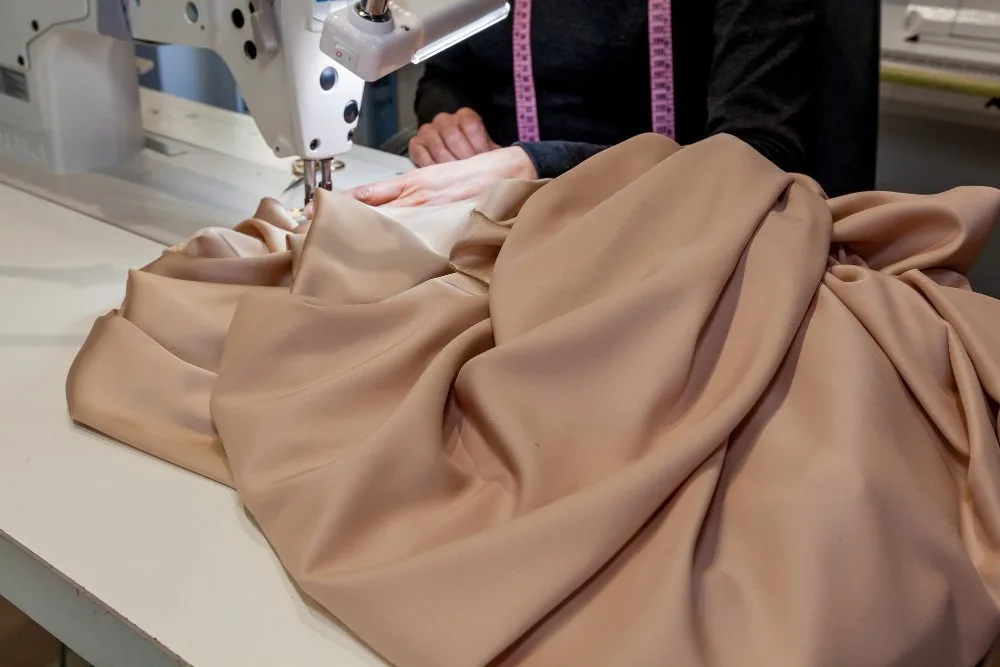
Good news for sewers: Dupioni is actually one of the easier silks to work with! Here’s everything you need to know about how to sew with silk dupioni.
Why Dupioni is Beginner-Friendly
Unlike slippery silks like charmeuse, Dupioni:
- Doesn’t slide around while cutting and sewing
- Has enough body to feed through the machine easily
- Doesn’t fray as quickly as looser weaves
- Shows pin holes less obviously than finer silks
Essential Sewing Supplies
- Needles: Size 70/10 or 80/12 universal or sharp needles. For hand sewing, use fine sharps or betweens.
- Thread: Cotton, polyester, or silk thread all work. Match the thread weight to your needle size.
- Pins: Fine silk pins or extra-fine glass-head pins to minimize holes
- Scissors: Very sharp fabric shears (dull blades will pull the silk)
- Seam ripper: For careful removal of mistakes (silk shows pin and needle holes)
Preparing Your Fabric
- Pre-wash if planning to wash finished item: Remember, Dupioni can shrink up to 10%.
- Press the fabric: Use a press cloth and medium heat to remove any wrinkles before cutting.
- Let it rest: Allow fabric to relax on a flat surface for a few hours after unrolling.
- Identify the grain: The slubs always run perpendicular to the grain. The grain runs along the smoother warp threads.
Cutting
- Use sharp scissors or a rotary cutter
- Cut on a single layer if possible for accuracy
- Use pattern weights rather than pins when possible (fewer holes)
- Mark with tailor’s chalk or washable fabric markers (test first on a scrap)
- Leave wider seam allowances (5/8″ or more) as insurance
Machine Sewing Settings
- Stitch length: 2.5 to 3.0 mm (standard length)
- Tension: Slightly looser than normal to prevent puckering
- Presser foot pressure: Light to medium
- Speed: Sew at a moderate pace for better control
Seam Finishes
Dupioni does fray, so seam finishing is important. Options include:
- French seams: Beautiful for transparent or lightweight projects, enclosing raw edges
- Serging: Quick and effective if you have a serger
- Zigzag or overcast stitch: Works well for most projects
- Hong Kong seams: Lovely for unlined jackets, using bias binding to enclose edges
- Full lining: The easiest solution, hiding all interior seams
Learn more about proper seam allowances and French seams for silk fabrics.
Interfacing
Dupioni works well with interfacing:
- Use lightweight fusible interfacing for collars, cuffs, and facings
- Test the fusible on a scrap first (heat and adhesive can damage silk)
- For couture projects, use silk organza as a sew-in interfacing
- Interface any areas that will bear stress (buttonholes, pocket openings)
Special Techniques
Bias Cutting
Dupioni is gorgeous cut on the bias! The bias grain adds slight stretch and creates beautiful drape even in this structured fabric. Just remember you’ll need about twice as much fabric for bias cutting.
Underlining
For formal garments, underlining with silk organza adds structure and durability. This is especially recommended for wedding dresses or garments that need to last through heavy wear.
Gathering and Pleating
Dupioni gathers and pleats beautifully due to its body. Use longer stitch lengths (4.0mm) for gathering stitches. The crisp nature holds pleats well without extensive pressing.
Hemming
Several hem options work for Dupioni:
- Hand-stitched hem: Most invisible, using a blind stitch or catch stitch
- Machine-stitched hem: Use a straight stitch or blind hem stitch
- Rolled hem: Beautiful for scarves and lightweight items
- Faced hem: Good for full circle skirts where a turned hem would be bulky
For more hem techniques, check out our guide on sewing perfect hems.
Common Mistakes to Avoid
- Don’t use a dull needle (it will snag the fabric)
- Avoid backstitching at the beginning and end (it can pucker); instead, leave long thread tails and tie them off
- Don’t press too hard (can create permanent shine marks)
- Never use regular tape or sticky notes on silk (adhesive can leave marks)
- Don’t skip test seams (always practice on scraps first)
How to Choose Quality Dupioni
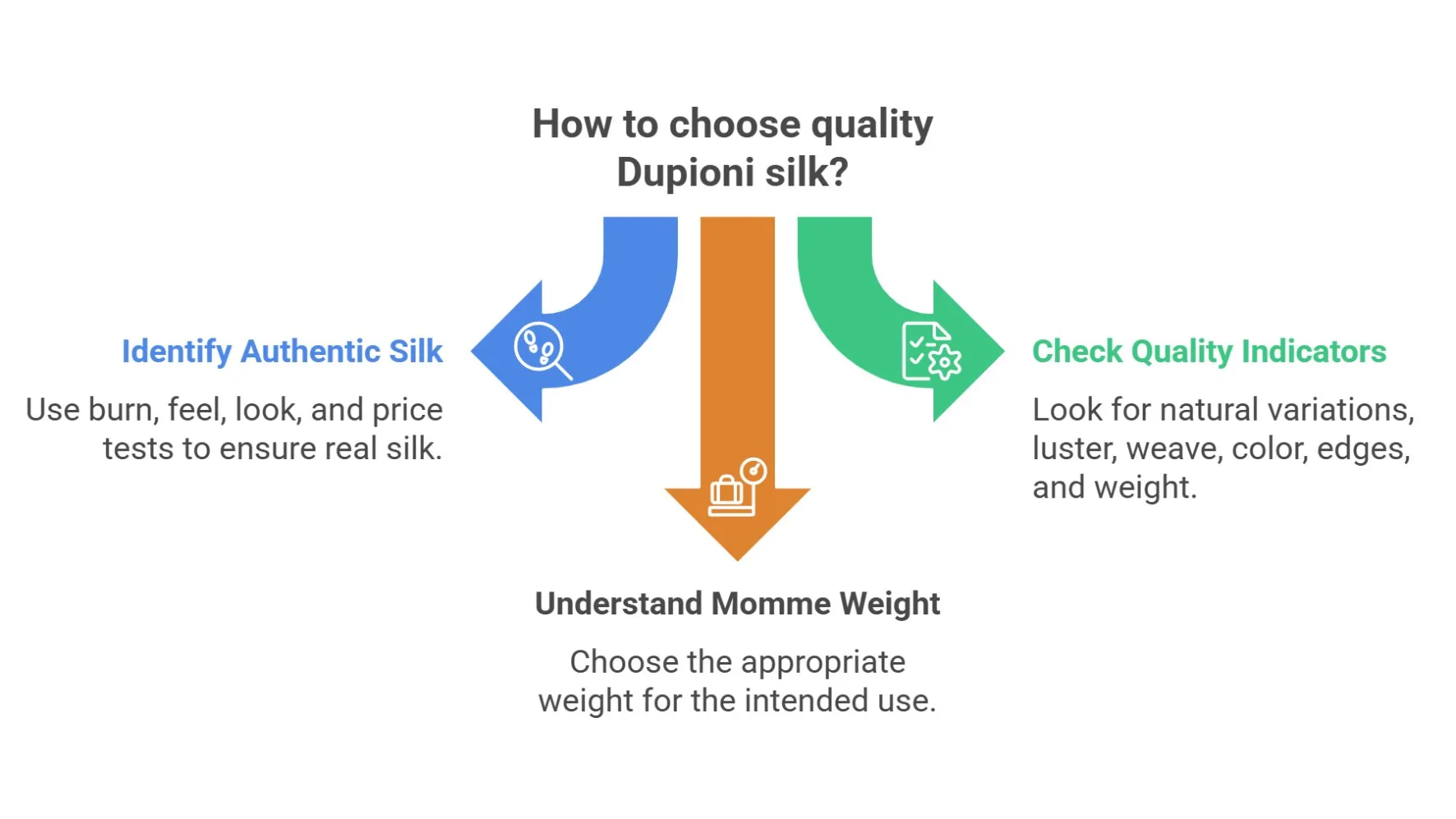
Not all Dupioni silk is created equal. Here’s how to spot good quality fabric.
Identifying Authentic Silk
First, make sure you’re buying real silk and not synthetic imitations:
- Burn test: A small thread of real silk burns slowly, smells like burning hair, and leaves brittle ash. Synthetic fabrics smell like plastic and leave hard, beady residue.
- Feel test: Real silk feels cool to the touch and warms up when you hold it. It also has a distinctive soft rustle.
- Look test: Real Dupioni has irregular slubs of varying sizes. Synthetic Dupioni has very uniform, repetitive patterns.
- Price test: If it’s suspiciously cheap, it’s probably synthetic. Real silk Dupioni typically costs $15-50+ per yard.
Quality Indicators
High-Quality Dupioni:
- Natural variation in slub size and placement
- Rich, deep luster (not artificial looking)
- Tight, even weave (hold up to light; high-quality has minimal light coming through)
- Consistent color throughout
- Clean edges that don’t immediately fray when touched
- 100% silk content (check the bolt end or ask for fiber content)
- Proper weight (should feel substantial, not tissue-thin)
Lower Quality Warning Signs:
- Very uniform, machine-regular slubs
- Excessive loose threads or pulls
- Thin spots or see-through areas
- Chemical smell (over-processing)
- Stiff but thin (heavy sizing to compensate for lightweight silk)
- Muddy or flat colors
Understanding Momme Weight
Momme (mm) is a unit measuring silk density. For Dupioni:
- 10-12 momme: Lightweight, suitable for linings or scarves
- 12-16 momme: Medium weight, good for dresses and blouses
- 16-19 momme: Heavier weight, perfect for home decor and structured garments
- 19+ momme: Very heavy, used for upholstery or special applications
Most Dupioni falls in the 14-17 momme range, which is versatile for both fashion and home decor.
Natural Characteristics vs. Defects
Remember, Dupioni is meant to have irregularities! These are features, not flaws:
- Slubs: The defining characteristic, not a defect
- Color variations: Slight color shifts from dye lots are normal
- Tiny nubs: Small bumps are part of the natural silk texture
- Minor irregularities: Hand-woven Dupioni will have slight variations
Actual defects to avoid:
- Holes or tears
- Pulled threads or snags
- Large thin spots where you can see through
- Excessive uneven dyeing (unless intentional ombré)
- Strong chemical odors that don’t air out
Buying Guide and Price Ranges
Ready to buy Dupioni silk? Here’s what you need to know.
Where to Buy
Online Retailers:
- Fabric specialty stores: Mood Fabrics, Fabric.com, Fashion Fabrics Club
- Etsy: Many vendors selling authentic Indian Dupioni
- Direct from manufacturers: Some Indian and Thai silk producers sell directly online
Physical Stores:
- Local fabric stores (call first to check stock)
- Bridal fabric specialty shops
- Home decor fabric stores
Tip on Buying Online:
Always order swatches first! Colors on screens don’t match real life, and you need to feel the fabric to assess quality. Most retailers offer swatches for $1-3.
Price Ranges (Per Yard)
- Budget Dupioni: $8-15/yard (usually blends or lower quality)
- Mid-range Dupioni: $15-30/yard (good quality for most projects)
- High-end Dupioni: $30-50/yard (hand-woven, exceptional quality)
- Luxury/Designer: $50+/yard (couture quality, often Italian)
Factors affecting price:
- Hand-woven vs. machine-woven
- Country of origin
- Silk quality (grade A vs. B silk)
- Width (54″ wide costs more than 45″ wide)
- Special effects (iridescent, embellished)
How Much to Buy
General guidelines:
- Simple dress: 3-5 yards depending on size and style
- Wedding gown: 6-10 yards (more for full skirts)
- Jacket or blazer: 2-3 yards
- Skirt: 2-3 yards
- Throw pillows: 1/2-1 yard per pillow (depending on size)
- Curtain panels (per panel): 2-3 times the window height
Always buy extra (10-15% more) to account for:
- Shrinkage if you plan to pre-wash
- Pattern matching if needed
- Cutting mistakes
- Future repairs or alterations
Budget Tip
Dupioni is more affordable than many other luxury silks. A wedding dress in silk charmeuse might cost $400+ in fabric alone, while Dupioni could be $200-300 for the same project.
Sustainability and Ethics
If you care about environmental and ethical factors (and who doesn’t these days?), here’s what you should know about Dupioni silk production.
Environmental Impact
Positive Aspects:
- Natural fiber: Silk is biodegradable and compostable
- Minimal processing: Compared to synthetics, silk production uses fewer chemicals
- Longevity: Quality Dupioni lasts for years, reducing waste
- Natural dyes available: Some producers use plant-based dyes
- Renewable resource: Silkworms regenerate each season
Concerns:
- Water usage: Silk production requires significant water for growing mulberry trees and processing cocoons
- Chemical dyes: Many commercial dyes contain heavy metals and pollutants
- Monoculture: Large-scale mulberry farming can impact biodiversity
Ethical Considerations
The main ethical issue with silk is that traditional production kills the silkworm inside the cocoon. Here’s what you should know:
Traditional Silk Production:
Cocoons are boiled with the pupae still inside. This is done because allowing the moth to emerge naturally breaks the silk filament into shorter pieces. Approximately 6,600 silkworms are needed to produce one kilogram of silk.
Peace Silk (Ahimsa Silk):
Peace silk allows the moth to emerge naturally before harvesting the cocoon. However:
- It’s more expensive (broken filaments require more processing)
- The texture is different (more irregular)
- It’s harder to find
- Some peace silk operations have been criticized for other animal welfare issues
Most Dupioni silk is NOT peace silk. If this matters to you, ask specifically and request certification.
Supporting Artisan Communities
Buying hand-woven Dupioni, especially from Varanasi or other traditional production centers, supports:
- Generations-old weaving traditions
- Fair wages for skilled artisans
- Small family businesses
- Cultural heritage preservation
Look for fair trade certified silk when possible.
Making Sustainable Choices
- Buy quality over quantity (one good piece beats several cheap ones)
- Choose timeless designs that won’t go out of style
- Care for your silk properly to extend its life
- Repurpose scraps for small projects
- Buy from transparent suppliers who share production details
- Consider vintage or second-hand silk
- Support local and small-batch producers when possible
Dupioni Silk Trends in 2025
What’s happening with Dupioni in the current fashion and design landscape? According to textile industry trend reports, natural silks are experiencing renewed interest as consumers seek sustainable luxury materials.
Home Decor Trends
Dupioni is experiencing a resurgence in interior design as part of the broader texture and luxury trend:
- Textured walls: Dupioni wallcoverings and wall hangings are gaining popularity
- Maximalist style: Rich textures like Dupioni fit the “more is more” aesthetic that’s replacing minimalism
- Layered curtains: Dupioni panels layered with sheers for added dimension
- Bold colors: Deep jewel tones (emerald, sapphire, ruby) are trending in Dupioni home decor
- Metallic accents: Subtle metallic threads woven into Dupioni for extra shimmer
Fashion Trends
- Structured silhouettes: With the return of 1950s-inspired fashion, Dupioni’s body and structure are perfect for full skirts and tailored jackets
- Statement sleeves: Puff sleeves and balloon sleeves in Dupioni create drama without weight
- Sustainable luxury: Natural silks like Dupioni appeal to eco-conscious consumers
- Artisanal appeal: The textured, handcrafted look of Dupioni fits the anti-fast-fashion movement
Color Trends for 2025
Popular Dupioni colors this year include:
- Earth tones: Terracotta, sage green, warm browns
- Dusty pastels: Muted roses, lavender, soft blues
- Rich jewel tones: Deep burgundy, forest green, midnight blue
- Iridescent combinations: Purple-gold, blue-green, copper-pink
- Classic neutrals: Champagne, ivory, and taupe remain timeless choices
Innovative Uses
Designers are finding new applications for Dupioni:
- Mixed media art incorporating silk
- Sustainable packaging for luxury goods
- Modern hanbok and fusion Asian fashion
- Eco-friendly event decor (replacing plastic decorations)
Frequently Asked Questions
Dupioni silk is made from double cocoons where two silkworms spin together, creating irregular threads with characteristic slubs (bumps). Regular smooth silk comes from single cocoons. Dupioni is crisper, more textured, and has more body than smooth silks like charmeuse or habotai.
Dupioni is moderately priced for silk. Expect to pay $15-50 per yard for quality Dupioni, with budget options around $8-15 and luxury versions $50+. It’s actually more affordable than many smooth silks like charmeuse, making it a good value for luxury fabric.
Yes, but hand washing is recommended over machine washing. Use cool water, gentle silk detergent, and never wring or twist the fabric. Dry cleaning is safer for formal garments or if you want to maintain the crisp texture. Washing will soften Dupioni and may cause up to 10% shrinkage.
Yes! Dupioni is actually one of the easiest silks to sew. Unlike slippery silks, it doesn’t slide around, has enough body to feed through a machine easily, and doesn’t fray as quickly. It’s a great choice for intermediate sewers ready to try working with silk.
The bumps (called slubs) occur when two silkworms spin their cocoons together, creating double cocoons. When these are unwound, the silk fibers are irregular and tangled together, producing thick and thin areas. These slubs are the defining characteristic of Dupioni silk and are intentional, not defects.
Yes, like all silks, Dupioni can fade and weaken with prolonged sun exposure. If using for window treatments, add a UV-protective lining. For display items, rotate them periodically and keep them out of direct sunlight to preserve color and strength.
Dupioni can be used for light upholstery like accent chairs, decorative cushions, and headboards, but it’s not suitable for high-traffic furniture like sofas. The fabric is more delicate than typical upholstery materials. Consider underlining it with cotton for added strength.
Iron on the silk setting (110-150°C) using a pressing cloth or iron on the wrong side. The fabric should be slightly damp for best results. You can also steam wrinkles out. Dupioni is relatively wrinkle-resistant compared to other silks, and small wrinkles often fall out on their own.
Store in a cool, dry place away from sunlight using breathable garment bags (not plastic). Fold with acid-free tissue paper, or hang if space allows. Keep away from perfumes, deodorants, and chemicals. Silk needs to breathe, so never store in airtight containers.
No, Dupioni is not itchy. While it has texture, it’s smooth silk and quite comfortable. The crisp hand softens with wear and washing. Some people find the texture more interesting than smooth silks. If you have very sensitive skin, try a sample against your skin before committing to a garment.
Yes, Dupioni dyes beautifully and accepts color well. You can dye it at home using acid dyes made for silk, or have it professionally dyed. The textured surface can create interesting dye effects with variations in color intensity around the slubs.
Cotton, polyester, or silk thread all work well with Dupioni. Choose a thread weight that matches your needle size (typically 50-60 weight thread). Silk thread gives the most luxurious finish but costs more. Good quality polyester thread is a practical alternative.
With proper care, Dupioni silk can last many years or even decades. It’s one of the more durable silks due to its double-thread construction. Historical garments made from Dupioni have survived over 100 years. The key is protecting it from sun, moisture, and rough handling.
Dupioni is perfect for bridal gowns because it holds the shape of full skirts, photographs beautifully with its natural sheen, creates lovely pleats and gathers, and is durable enough to last through a long wedding day. The slight texture adds visual interest without competing with lace or embellishments.
Generally no. Dupioni is a tightly woven, medium-weight silk that’s not sheer. However, very lightweight Dupioni (under 12 momme) or light colors may be slightly transparent. For garments, lining is recommended both for opacity and to protect the silk from body oils.
Conclusion
After this deep dive into Dupioni silk, you should now understand why this fabric has remained popular for centuries. Its unique combination of texture, durability, and natural beauty makes it stand out in the world of silk fabrics.
Dupioni silk isn’t just another pretty fabric. It’s a textile with personality, history, and character. Those slubs that make it distinctive? They’re actually created through a natural occurrence when two silkworms decide to share a cocoon. Pretty amazing when you think about it.
When to Choose Dupioni:
Pick Dupioni silk when you want a fabric with structure and body, need something that photographs beautifully, want a luxurious look without breaking the bank, are creating formal wear or special occasion items, need durability in a silk fabric, or want to add texture and visual interest to home decor.
When to Skip It:
Choose a different silk if you want flowing, drapey garments, need something suitable for everyday casual wear, want perfectly smooth texture, require easy machine washing, or are looking for athletic or activewear fabrics.
Final Recommendations
For Fashion Projects: Dupioni shines in structured garments like wedding dresses, formal gowns, tailored jackets, and full skirts. Always buy extra fabric to account for shrinkage if you plan to wash it, and consider pre-washing to soften the hand. Don’t be afraid to mix it with other fabrics for modern looks.
For Home Decor: Use Dupioni for curtains (with UV lining), decorative pillows, and upholstered accent pieces. The texture adds instant elegance to any room. Remember that it will fade in direct sunlight, so plan accordingly.
For Sewers: If you’re new to sewing with silk, Dupioni is actually a great place to start. It’s forgiving, doesn’t slip around, and the texture hides minor stitching imperfections. Just use sharp needles, practice on scraps first, and you’ll be fine.
For Care: Dry cleaning is safest, but hand washing is totally doable and will give you a softer fabric. Store properly away from light and moisture, and your Dupioni will last for years.
Making the Investment
While Dupioni isn’t the cheapest fabric, it’s actually quite affordable for real silk. A dress that might cost $400 in fabric using charmeuse might only cost $200-300 in Dupioni. Plus, its durability means you’re getting more value over time.
When shopping, don’t be afraid to ask questions about where the silk comes from, how it’s made, and what the fiber content is. Buy swatches before committing to full yardage. And remember: those slubs and irregularities are features, not flaws. They’re what make your Dupioni piece unique.
Looking Forward
As fashion and design continue to move toward texture, craftsmanship, and sustainability, Dupioni silk is perfectly positioned to remain relevant. Its natural fiber content, artisanal production methods, and timeless appeal align with current consumer values.
Whether you’re planning a wedding, updating your home decor, or just wanting to try sewing with silk for the first time, Dupioni offers a beautiful combination of luxury and practicality. Its perfectly imperfect texture tells a story, its natural sheen catches the light beautifully, and its durability means your creation will last.
Now that you understand what makes Dupioni special, how to work with it, and how to care for it, you’re ready to make an informed decision. Whether you fall in love with that characteristic slub or prefer the smooth perfection of other silks, at least now you know exactly what Dupioni brings to the table.
For more information about different silk types and what to know about silk fabric, continue exploring and learning. The world of silk is rich and varied, and Dupioni is just one beautiful thread in that tapestry.
Happy sewing, decorating, or whatever creative project brings you to this wonderful fabric!
Ready to Work with Dupioni Silk?
Check out our Silk Care Calculator to get personalized washing instructions, and use our Fabric Yardage Calculator to determine exactly how much Dupioni you’ll need for your project.
This article was last updated in November 2025 with the latest information on Dupioni silk production, care techniques, and current trends.

